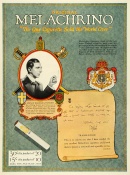Chapter 19
Contents
Page 132
"ocean liner Stupendica"The S.S. Stupendica makes an appearance in Pynchon's Against the Day, being the liner the Zombini family takes to Europe for a tour. Discussion
"smoking a Melachrino in a jade holder"Melachrino cigarettes — "the aristocratic Egyptian cigarette" — were an Egyptian brand popular from the late 19th century through mid-20th century. In its advertising it emphasized Orientalism (romanticizing "the East"), worldliness and sophistication, and high-class leisure (opera, hotels, international travel).
Page 133
junior purser
This would be an assistant to the purser on an ocean liner who was the ship’s chief administrative and financial officer — essentially the head of the ship’s hotel, passenger, and business operations, while the captain handled navigation and command.
Page 134
"furtive Ronald Colman faces"
The on-screen characters played by English actor Ronald Colman (1891-1958) could be described as quiet, elegant, and inward. He projected cultivated restraint: a man of gentle intelligence, lightly ironic charm, and emotion held just beneath the surface. Even in dramatic moments, he remained composed, conveying depth through voice, posture, and a faint, private sadness rather than overt display.
"current husband Porfirio"
Perhaps the name alludes to Porfirio Diaz, the dictator of Mexico from 1876 until his overthrow in 1911. Over time, his "Spanish-sounding" name became shorthand for a romantic, flamboyant, suave, and slightly ridiculous Latin lover. During the post–Rudolph Valentino "Latin Lover" craze, and the name "Porfirio" was often deployed by comic writers, vaudeville routines, dance-hall jokes, and humor columns.
autogyro
an early type of rotary-wing aircraft invented in the 1920s by the Spanish engineer Juan de la Cierva. It looks a bit like a small airplane with a free-spinning rotor on top.
"One of those rigs [...] I keep seeing in Popular Mechanics
January 1929, Popular Mechanics ran one of the first U.S. popular press features on Juan de la Cierva’s autogyro, explaining the principle of autorotation and showing the early Cierva models being tested in Europe. It continued to feature the planes throughout the years.
Gaudeamus igitur
The opening line of a medieval student drinking song that became the traditional university graduation song across Europe. The full title is usually Gaudeamus Igitur, Juvenes Dum Sumus ("Let us rejoice, therefore, while we are young.")
